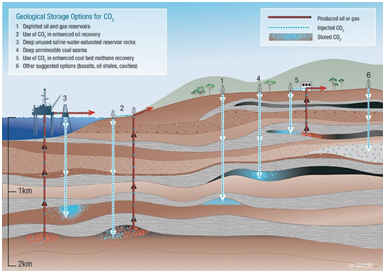

8th September 2025 (12 Topics)
Context:
A new Nature study has found that the Earth can only safely hold about 1,460 billion tonnes of CO? underground, far less than earlier estimates.
Concept
- Carbon Capture and Storage/Carbon Capture, Utilisation and Storageinvolves capturing CO? from large emission sources (power plants, cement, steel, refineries) and storing it deep underground in geological formations (~2 km depth).
- Aim: Prevent release of anthropogenic CO? into the atmosphere, mitigate climate change, and enable low-carbon industrial transitions.
Process Stages
- Capture:
- From stationary sources (power stations, hydrogen production, cement, steel, natural gas processing).
- Direct Air Capture and Storage (DACS) under research.

- Transport:
- Via pipelines, ships, trucks, or rail, similar to natural gas transport.
- Injection & Storage:
- Stored in saline aquifers, depleted oil/gas fields, deep coal seams, or basalts.
- CO? trapped in pore spaces ? dissolves in brine ? reacts to form stable minerals.
- Utilisation (CCUS):
-
- Enhanced Oil Recovery (EOR): injecting CO? into mature oil fields.
- Production of fertilisers, fuels, plastics, and food products.
- Currently, industry mostly uses naturally accumulated CO?, but anthropogenic CO? could replace this.
-
Geological Carbon Storage (GCS):
- Involves capturing CO? from sources like power plants or the atmosphere and injecting it into deep rock formations.
- Expected to help achieve Paris Agreement targets of limiting warming below 2°C.
Revised Capacity Estimates:
- Previous estimates: ~11,800 billion tonnes of storage.
- New safe limit:1,460 billion tonnes (just 10% of earlier figure).
- High storage potential in Russia, USA, Saudi Arabia; low in India and Europe.
Implications:
- Maximum possible reversal of warming through storage is only 7°C.
- Storage alone cannot solve climate change ? emission cuts remain the primary solution.
- Raises policy dilemma: whether to use storage to extend fossil fuel use or prioritize carbon removal for future generations.
More Articles


